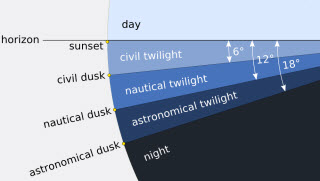 As nights become ever lighter, now may be a good opportunity to briefly explain why the changes in light levels encountered daily after sunset or before sunrise occur. If you were to step outside in autumn, winter or early spring, skies are fully darkened by around 21:00h. This deepest level of darkness, known as Astronomical twilight, is just one of three levels experienced, the others being Civil and Nautical twilight respectively. However, because of our location (latitude) on the surface of the globe, as Earth orbits around the Sun, the duration of twilight levels varies considerably. So let me explain a little further using evening twilight as an example.
As nights become ever lighter, now may be a good opportunity to briefly explain why the changes in light levels encountered daily after sunset or before sunrise occur. If you were to step outside in autumn, winter or early spring, skies are fully darkened by around 21:00h. This deepest level of darkness, known as Astronomical twilight, is just one of three levels experienced, the others being Civil and Nautical twilight respectively. However, because of our location (latitude) on the surface of the globe, as Earth orbits around the Sun, the duration of twilight levels varies considerably. So let me explain a little further using evening twilight as an example.
Immediately after sunset Civil twilight exists until the Sun is approximately 6 degrees below the horizon. At this point normal daytime activities that require light cease to be possible and 'lighting up' time occurs. If skies are really clear look out for an interesting phenomena half an hour or so after sunset, opposite the position of sunset. In this direction a hazy, dark-ish purple band just above the ESE horizon gradually 'heaps up' before being engulfed by deepening twilight. This is not mist but the shadow of Earth itself, being cast back into space!
As the Earth spins a little further round and the Sun's elevation below the horizon reaches approximately 12 degrees, the marine horizon is no longer apparent and Nautical twilight exists. In the heavens only the brighter navigational stars are visible. Finally, when the Sun drops approximately 18 degrees below the horizon (a hands span) Astronomical twilight commences and the remaining fainter stars become visible, unless light pollution drowns them out. With the approach of dawn the same lighting levels are experienced - only in reverse.
As we move toward summer the northern hemisphere is inclined towards the Sun and twilight duration's alter significantly. From the latitude of Whitby astronomical twilight is totally absent for 82 nights; from late May until mid August. The Suns journey beneath the horizon is so shallow it never actually reaches 18 degrees. Matters become worse (for the astronomer) around the summer solstice when even nautical twilight levels barely exist here, the Sun setting by a mere dozen degrees. At least from northern England summer astronomy is just about possible, but as you travel further north nocturnal conditions grow ever lighter and only 13 degrees north of Whitby at latitude 67 degrees N (the Arctic Circle) twilight on any level is completely absent for part of summer and the Sun is visible above the horizon 24 hours a day. Only solar observers are completely happy for in the land of "midnight sun" star gazing is limited to just one, that is if it's not cloudy!
- Log in to post comments

